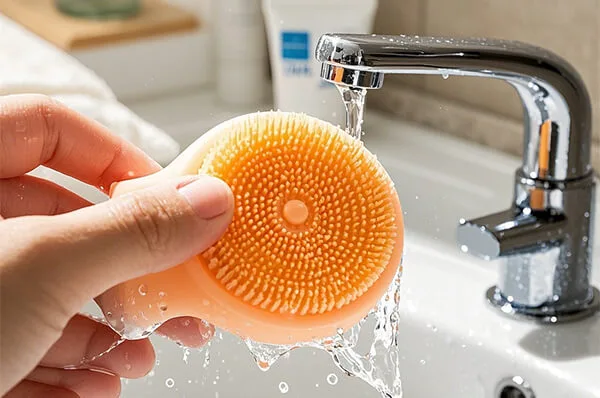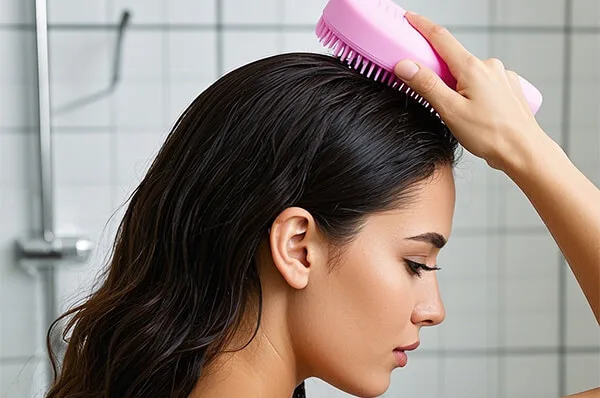- Have any questions?
- +86 19574832024
- admin@beaut-lohas.com
In the daily affairs of parenting, bathing a baby is an extremely important part. And as a common bathing tool, silicone body scrubbers often make parents wonder if they are suitable for use in baby bathing.
Silicone body scrubbers do have their unique features. Their material is soft and elastic, which significantly reduces the risk of scratching a baby’s delicate skin compared to some traditional hard-bristled body scrubbers. Silicone itself is not prone to breeding bacteria and is relatively easy to clean and maintain hygiene, which is especially important in a humid bathroom environment. Their special design can also help parents clean various parts of a baby’s body more comprehensively and carefully, such as the back, neck, and other areas that are difficult for the baby to clean by themselves.
However, using a silicone body scrubber to bathe a baby is not without concerns, and the following precautions must be taken seriously.
From the perspective of the baby’s age, the neonatal stage is an extremely special period. The baby has just left the protection of the mother’s body, and the skin cuticle is as thin as a cicada’s wings, with weak defense capabilities. At this time, even a soft silicone body scrubber may cause excessive irritation to the baby’s skin. Generally speaking, before the baby is one month old, the use of silicone body scrubbers should be avoided as much as possible. It is best to use a soft gauze or towel dipped in water to gently wipe the baby’s body. When the baby is 1 – 3 months old, silicone body scrubbers can be used selectively and extremely cautiously. For example, on the baby’s limbs, gently pass the silicone body scrubber and observe the baby’s reaction, but still avoid frequent use and vigorous wiping. For babies over three months old, if the skin condition is good and there are no skin problems such as eczema or prickly heat, silicone body scrubbers can be used relatively regularly, but the frequency of use is recommended to be controlled at 1 – 2 times a week.
Regarding the frequency of using silicone body scrubbers, it is essential to get it right. The surface of a baby’s skin has a natural oil protective film, which plays a crucial role in maintaining skin moisture and resisting external stimuli. Using a silicone body scrubber too frequently will damage this protective film, making the skin dry, rough, and even causing symptoms such as itching. Therefore, in addition to the frequency limit of 1 – 2 times a week mentioned above, during seasonal transitions and dry climates, the number of uses should also be appropriately reduced. For example, in autumn and winter, when the air humidity is low and the baby’s skin is prone to dehydration, the interval between using silicone bath brushes can be extended to 10 – 15 days, and baby-specific moisturizing skin care products should be applied promptly after bathing.
Controlling the force when using a silicone bath brush is of utmost importance. Parents should always remember that a baby’s skin is extremely delicate, and any slight improper force may leave marks. When using a silicone body scrubber, it should be gently placed on the baby’s skin, and cleaning should be carried out in an extremely gentle circular or unidirectional wiping manner. For example, when cleaning the baby’s back, it should not be brushed back and forth vigorously like an adult’s bath, but only let the silicone bristles slightly touch the skin and slowly move from the shoulders to the waist. When cleaning more sensitive areas such as the baby’s abdomen and chest, even more care should be taken to minimize the friction time and force between the silicone body scrubber and the skin. It should be particularly noted that the baby’s joint areas, such as elbows, knees, wrists, ankles, etc., have more skin folds, and the skin in these areas is more sensitive. The silicone bath brush must be avoided or only touched extremely lightly when used.
The combination of cleaning products cannot be overlooked. A silicone body scrubber cannot be used to dry-brush a baby’s body directly; it must be used with an appropriate amount of bath products. However, a mild, non-irritating, moderately acidic and alkaline bath gel specially designed for infants should be selected. When using the bath gel, it should be first rubbed into rich foam in the hands, and then the silicone body scrubber should be dipped in the foam and gently applied to the baby’s body for cleaning. Moreover, after using the bath gel, the baby’s body must be thoroughly rinsed with a large amount of clean water to ensure that there is no residue of the bath gel. Because the residual bath gel may irritate the baby’s skin, causing allergic reactions or skin inflammation.
The cleaning and maintenance of the silicone body scrubber itself are also crucial. After each use of the silicone bath brush, it should be immediately rinsed repeatedly with running water to thoroughly remove the dirt, skin flakes, bath gel, etc. remaining between the bristles. Then it should be placed in a well-ventilated and dry place to dry, avoiding being placed in a damp and dark corner to prevent the growth of bacteria and mold. If it is found that the silicone body scrubber has bristles falling off, deformation, discoloration, or an unpleasant smell, it should be discarded without hesitation and replaced with a new one. Never continue to use a defective body scrubber to bathe the baby to avoid potential threats to the baby’s health.
In addition, if the baby has skin diseases such as eczema or atopic dermatitis, the use of silicone body scrubbers should be suspended during the onset of the disease to avoid aggravating skin damage and discomfort. After the baby’s skin recovers, the use can be resumed cautiously according to the situation.
In conclusion, a silicone body scrubber can be a helpful little assistant in the process of baby bathing, but only if parents fully understand and strictly follow the various precautions mentioned above. In the journey of parenting, every detail is related to the baby’s health and growth. Only with careful care can the baby thrive in a safe and comfortable environment.




